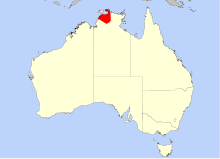Drosera fulva
| Drosera fulva | ||||||||||||
|---|---|---|---|---|---|---|---|---|---|---|---|---|
| Systematics | ||||||||||||
|
||||||||||||
| Scientific name | ||||||||||||
| Drosera fulva | ||||||||||||
| Planch. |
Drosera fulva is a carnivorous plant from the sundew family(Droseraceae). It occurs exclusively in Australia in the Northern Territory .
description
In Drosera fulva is a perennial herbaceous plant , forms the individual down-rosettes. The leaves are half upright to extended, the petioles are inverted-lanceolate, 25 to 30 millimeters long, 0.6 to 1.2 millimeters at the base, later widening to 2 to 3 millimeters wide, at the base of the blade tapers to 0 , 8 to 1 millimeter, bald on the upper side and occasionally covered with white hairs on the underside, dense white woolly hairs on both sides during the dry season. The round leaf blades are 2 to 3 millimeters long and equally millimeters wide, covered with small glands on the upper side and fang tentacles on the edge and slightly hairy on the underside, densely woolly covered with white hairs during the dry season.
Flowering time is February to May. The one or two densely hairy inflorescence axes are 25 to 45 centimeters long and carry fifty or more flowers in a cluster , the flower stalks are 1 to 2 millimeters long. The sepals are inverted egg-shaped, densely hairy white, 3 to 3.5 millimeters long and 1.5 to 1.8 millimeters wide. The petals are white, rarely pink, inverted egg-shaped and 6.5 to 9 millimeters long and 4 to 6.5 millimeters wide.
The stamens are around 3 millimeters long. The ovary is the reverse-ovoid, and 0.8 to 1 millimeter long. The 3 styluses are 2 millimeters long including the scars .
distribution
Drosera fulva is native to Australia. There it occurs in the Northern Territory in the area around Darwin in sandy soils on moist plains, in seepage water zones and briefly flooded depressions immediately above the high water mark. It is common and harmless in its area of distribution.
Systematics
The species was first described in 1848 by Jules Émile Planchon , it belongs to the so-called "Petiolaris complex", which forms the Lasiocephala section of the genus. The closest related species are Drosera brevicornis and Drosera dilatatio-petiolaris .
literature
- Allen Lowrie : New species in Drosera sect. Lasiocephala (Droseraceae) from tropical northern Australia. In: Nuytsia . Vol. 11, No. 1, 1996, pp. 55-69 .
